Reptiles
AUSTRALASIAN Tropical & Subtropical Moist Broadleaf Forest
Reptilia
This section groups together what have often been considered the ‘reptiles’. For evolutionary and taxonomic reasons, this has been known to be a false group for a long time, but I'll stick to it for convenience.
Order Squamata: Lizards and Snakes
Family Gekkonidae
Geckos are a family of mainly nocturnal lizards. They usually have slim bodies with long limbs, and often have fat or strangely shaped tails. Their skin appears rather soft, and includes a range of colours, from cryptic green and browns to striking bands. They usually have a flattened round head with a distinct snout. Their most distinctive features are the large, lidless eyes which do not blink, but are licked clean by the tongue. Another feature is their ability to make noises, although most of the native species are quiet. In Australia, there are over 110 species. They seem to be more of the drier habitats, and are surprisingly less diverse in the tropical rainforest. They are also rarely seen in this habitat, with the most commonly seen gecko in rainforest lodges being an introduced species.
Phyllurus spp. and Saltuarius spp.

Saltuarius cornutus, ‘Northern Leaf Tailed Gecko’. Large gecko with leaf shaped tail, lichen-like camouflage skin. Eyeshine may give it away when spotlighting rainforest. Usually pressed on tree trunk high up in canopy, often head pointed down and slightly away from tree, but if disturbed flattens out against trunk to reduce shadow. Only found in rainforests of North Queensland. Best seen at the giant Fig Trees and Hypipamee Crater in Atherton Tablelands.
Carphodactylus spp.
This genus has only 1 species, which is endemic to Australia.
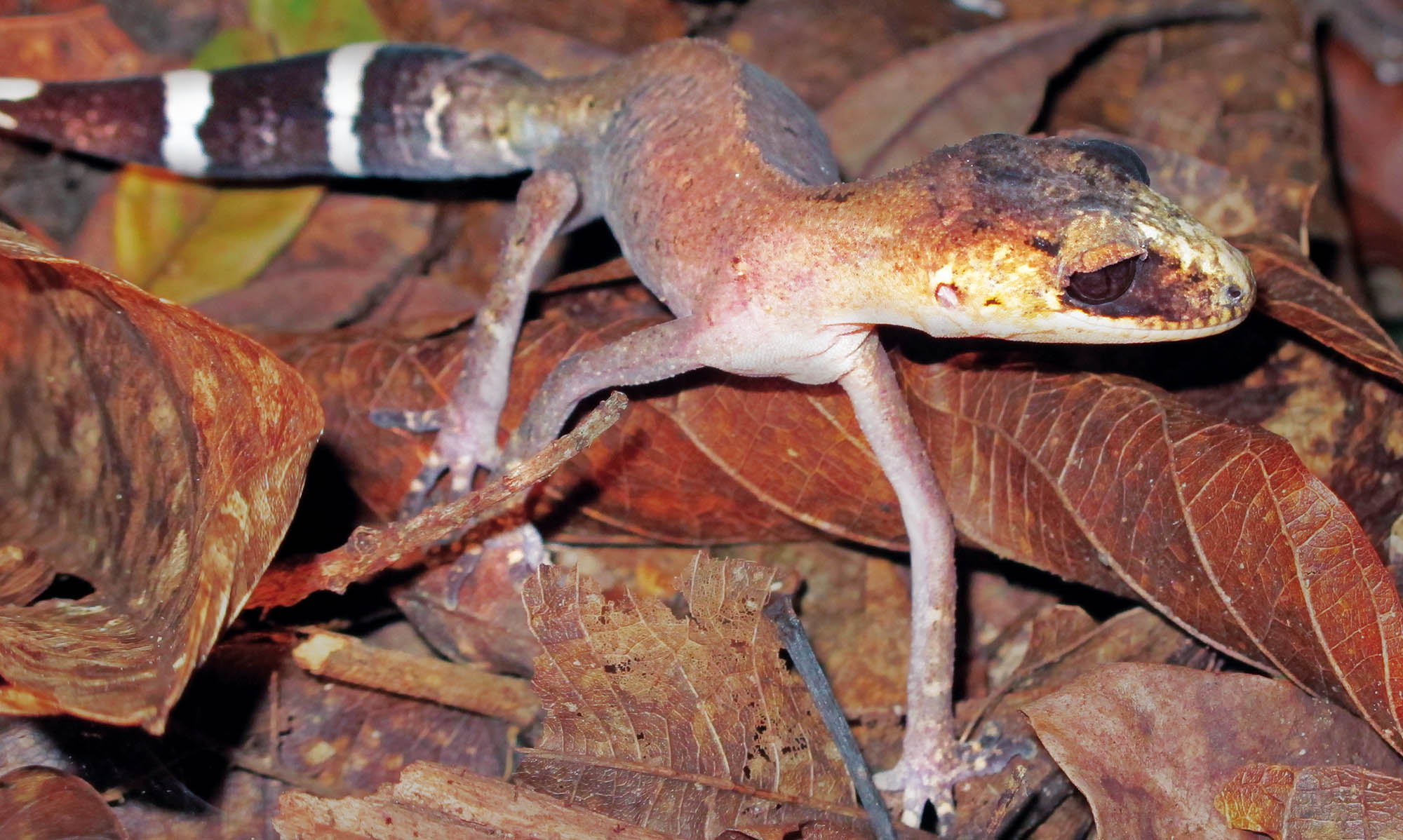
Carphodactylus laevis, ‘Chameleon Gecko’. Relatively slender body, laterally compressed, long limbs, huge black eyes with ‘black eye’ smudge on snout. Carrot shaped tail; if the animal still has original tail, then it has several bold white stripes. Wilson and Swan report the unique ability of this species to discard the tail, which then wriggles around and makes squeaking noises! May be seen on ground at night in tropical rainforest. Found only in North Queensland.
Family Agamidae: Dragons
Dragons are found from Europe, to Africa, Asia, Australia, and the south Pacific. There are some 70 species in Australia, but, like the geckos, they are more common in drier habitats and relatively less diverse in the Australian rainforest. Most dragons have large angular heads, sometimes with flaps, spines or frills. They have long bodies, strong hind legs and long toes, and very long tails. They generally have an upright posture and some species can run quickly on their hindlegs when alarmed.

Intelligama lesueurii, 'Eastern (Australian) Water Dragon'. Found in forests, particularly along river, in eastern Australia. If alarmed, they jump into water and swim away; they can rest on the bottom underwater for up to a hour and a half. They are also becoming common in suburbs of northern NSW and south-east Queensland, where they end up in people's pools and backyard ponds.
Hypsilurus spp.‘Rainforest’ or ‘Angle-headed Dragons’
 (captive, Featherdale)
(captive, Featherdale)This genus is centred in the rainforests of New Guinea, with 2 species also found in the rainforests in eastern Australia. They are medium to large lizards with long legs and head crests. Their eyes are large compared to other open habitat dragons of Australia perhaps due to the low light levels of their rainforest understorey habitat. They are difficult to spot as they perch very still in the first few metres of a rainforest trunk. From here they watch for prey and avoid detection by predators; if spotted, they will slowly edge around the other side of the trunk.
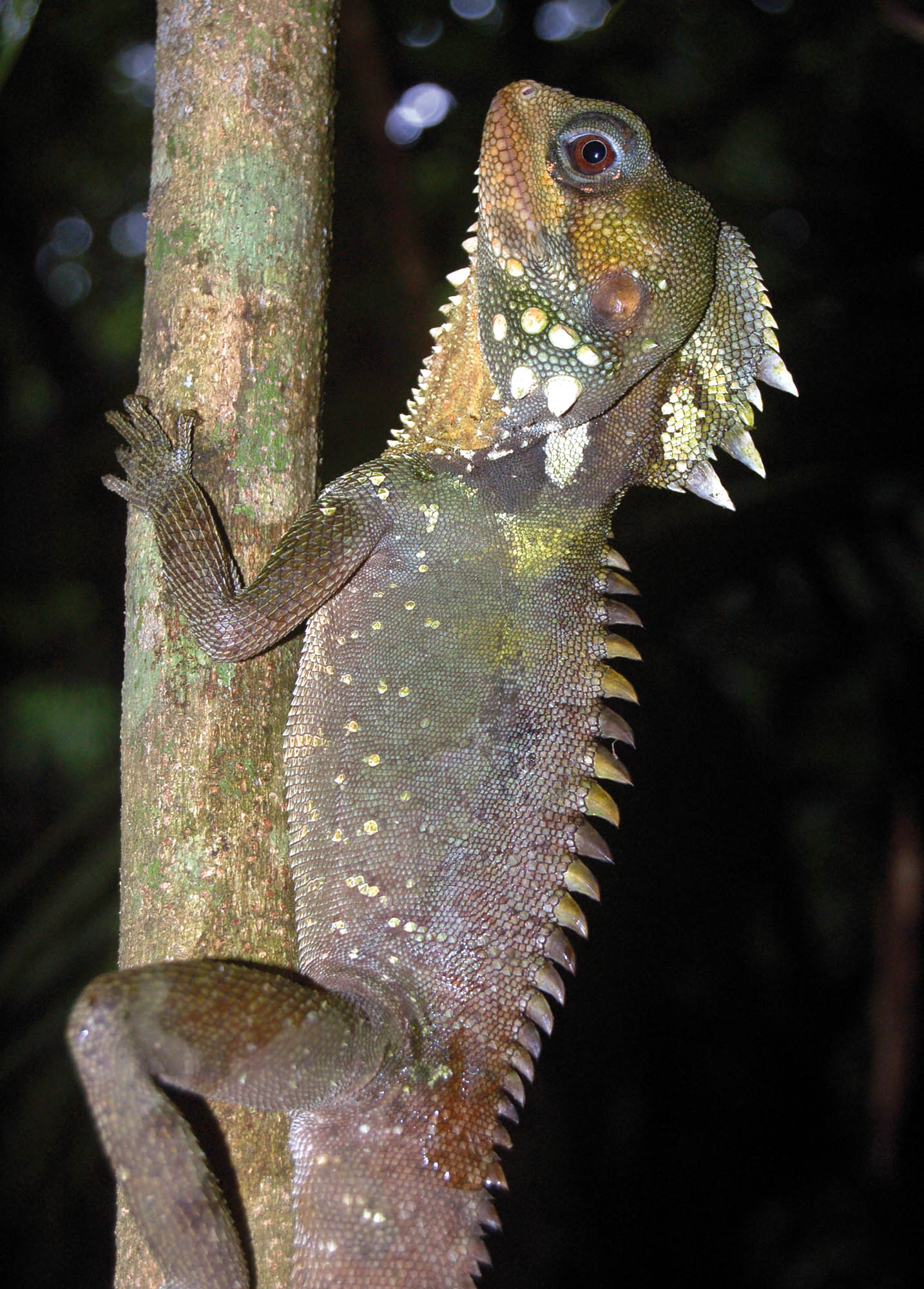 (Mossman Gorge)
(Mossman Gorge)Hypsilurus boydii Boyd’s ‘Forest Dragon’. Striking lizard. About 15 cm long, not including the long tail. Large head and large eyes. Spines along back, and throat. Has white ‘stones’ embedded on the cheeks. Only found in tropical rainforest in north-east Queensland. Can sometimes be seen on walking tracks at Mossman Gorge, Lake Barrine.
Family Varanidae: Monitor Lizards
There are over 50 species of monitors and they are found in Africa, Asia and Australia, with the latter region having the highest diversity, with over half of all species. The name monitor originates in Africa, while the name goanna is commonly used in Australia, thus ‘goanna’ and ‘monitor’ refer to the same animals in Australia, and can be used interchangeably. Monitors walk with their body held up, but still low to the ground, and with alternate movements of the opposite limbs. They have large feet and sharp claws that in many species are used for climbing and/or digging, and have a large, strong tail.
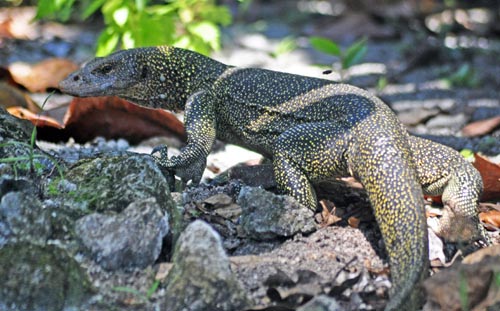 (Marovoa Lagoon, Solomon Islands)
(Marovoa Lagoon, Solomon Islands)Varanus indica, 'Mangrove Monitor', Western Pacific Monitor Lizard'. Large distribution from Australia, New Guinea, Solomon Islands, up to Micronesia. They may have been able to disperse this far due to their salt-excreting nasal glands, which only one other monitor has.
Family Scincidae: ‘Skinks’
The skinks make up the largest of all lizard families, with over 1,500 species and continuing, with new species being discovered every year. They have adapted to almost every terrestrial niche on the planet. They are particularly diverse on the Australian continent, with over 380 species, and are common in most habitats, including rainforest. There is a huge range in size and shape in skinks, however, the typical garden variety; small, slim and fast, is indicative of the family in general. Most species have long bodies, thin limbs and very long tails. Skinks have distinctively shorter limbs than most other lizards. They tend to have large symmetrical shield scales on the head, and the body scales are usually small, smooth and round. As most species are primarily diurnal, they have small eyes.
Gnypetoscincus spp.
There is only 1 species in this genus.
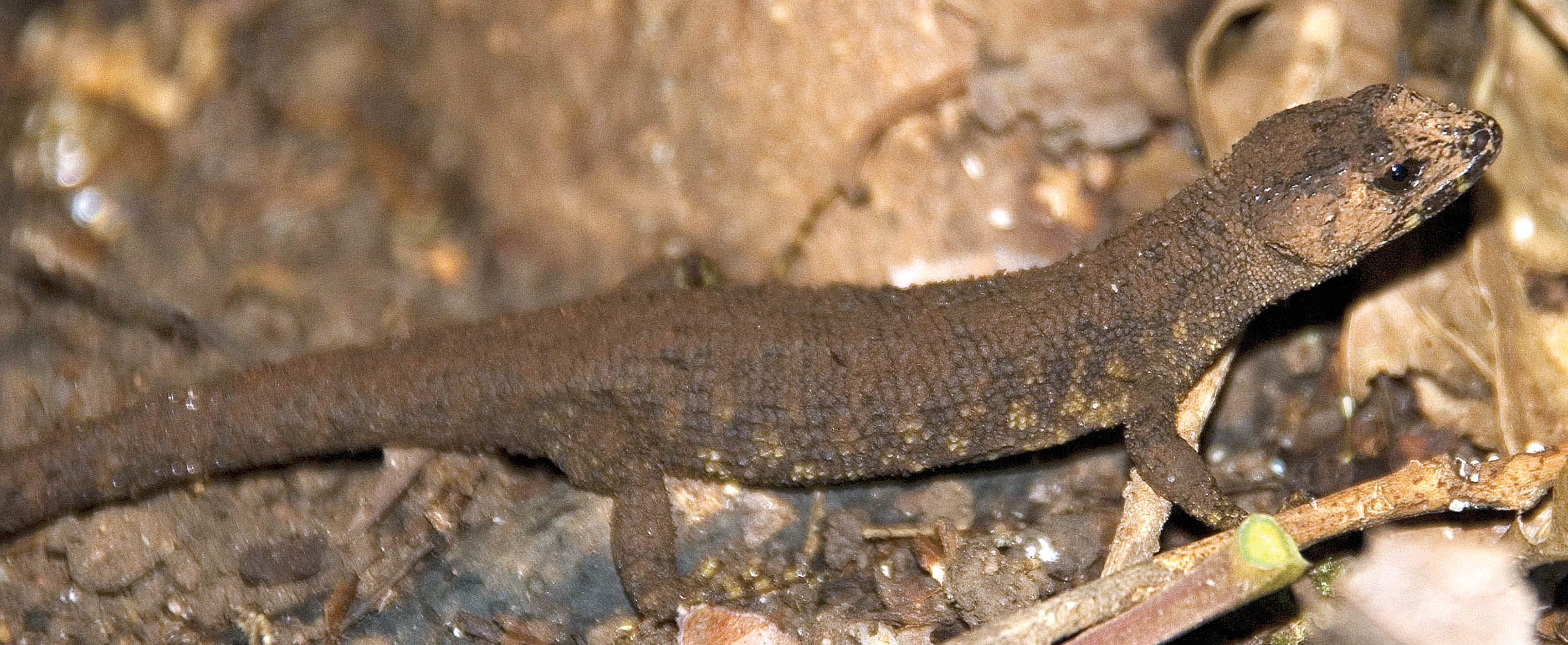 (Hypipamee Crater)
(Hypipamee Crater)Gnypetoscincus queenslandiae, ‘Prickly Forest Skink’ is endemic to north-east Queensland, where it is restricted to the tropical rainforest. This unusual lizard has points to the scales along the back and thus appears ‘prickly’. It is rarely seen as it is reported to feed on invertebrates inside rotting logs.
Egernia spp.

This genus has 30 species in Australia and includes some of the larger, more robust skinks. The main species found in the Australian tropical rainforest is the large and fat Egernia frerei ‘Major Skink’, sometimes seen near logs by the path at Mossman Gorge, but probably best seen on Fitzroy Island, and which also occurs in southern New Guinea.
Eulamprus spp. ‘Water skinks’

A group of about 15 medium-sized species found in wetter habitats along the east cost of Australia. They tend to have copper or even golden backs, with black and white flecks or bars along the sides
Suborder Serpentes ‘Snakes’
Snakes probably evolved from lizards and into a very specialized group with a distinctive elongate form and no limbs. This form has obviously been very successful, as 3,900 different species swim, climb and burrow through a range of habitats, from the ocean through forests and grasslands, to deserts. Because of their wriggling locomotion and their often shiny appearance, many people think of snakes as slippery, however, their bodies are dry to the touch, and larger snakes are much like feeling a long muscular arm. They have some internal adaptations for their long body, including a long and thin liver, kidneys one after another rather than side by side, and a severely reduced left lung. Almost all snakes feed on other animals, with prey often being large and alive, and they have evolved various unusual features to accommodate these habits. Because snakes have a relatively thin body and are eating large animals, they have a very elastic head and body for engulfing their prey. The jaws can open very wide, and in many species the jaws literally separate from the skull to swallow the victim whole. Once inside, the lack of full encircling girdle and ribs enables the body to stretch considerably to accommodate the animal. To actually kill the prey so it doesn’t tear the inside of the animal apart, snakes either constrict their victims, or inject venom into them. This latter feature has resulted in the evolution of some of the most venomous animals on the planet. This probably accounts for much of the fear humans have of these creatures, however, they are usually reasonably shy animals, and most slide away when they hear humans thumping along a track.
Despite the fears of many casual visitors, snakes are not encountered that often in the tropical rainforest. They are generally shy and blend in fairly well with their environment. Also fortunate is the fact that most of the more commonly seen species in the Australasian tropical rainforest are not deadly to humans. Instead, it is groups such as the rear-fanged tree snakes and the non- venomous pythons that are observed in this habitat. The most dangerous snakes in tropical and subtropical Australia, region, such as Brown Snakes and Taipans, are rarely found in the rainforest itself, but rather in the adjacent savanna woodlands and sugar cane fields (so you are actually safer from snakes inside the forest than outside!). The best chances of observing snakes is probably on boat cruises, such as on the Daintree River and Lake Barrine.
Family Pythonidae: Pythons
The 25 species of Pythons are mainly found in the Old World tropics and subtropics, including Africa, Asia and Australia. They have reached their highest diversity in Australasia, where about half of the world’s species are found, and very well represented in the tropical rainforest here. Pythons are related to the Boas that are primarily in the American tropics, but differ from them in several reproductive aspects, such as the fact that they lay eggs. In contrast to most other snakes, female pythons show parental care; they wrap their body around their eggs and vibrate to keep them warm. Pythons generally tend to prey on vertebrates, and are notable for taking birds and mammals. They pick up chemical cues, and most can detect the heat from their prey with organs on their ‘lips’. These sensor pits and their enlarged scales around the mouth are lacking only in a few species in the family, and are thus one of the most distinctive features with which to identify a snake as a python.
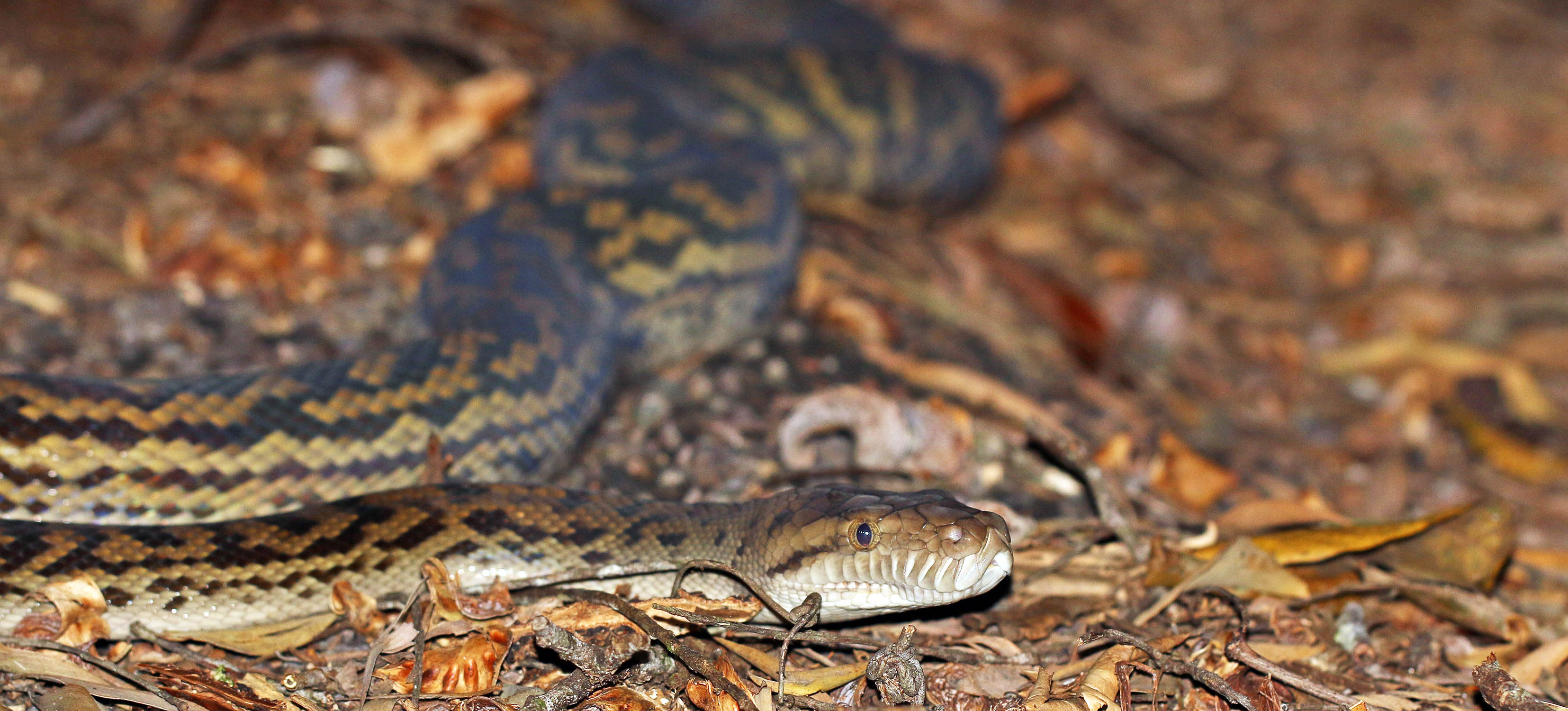 (Atherton Tablelands, Queensland, Australia)
(Atherton Tablelands, Queensland, Australia)Simalia (formerly Morelia) kinghorni, ‘Australian Scrub Python'. Usually (but not universally) split from a species that is also distributed north into south-east Asia, Simalia (formerly Morelia) amethystina, ‘AmethystinePython' . This is Australia’s biggest snake. Usually found in or near tropical rainforest. Strange, almost blue’ish sheen to scales in certain light. Generally arboreal (tree dwelling) and nocturnal, although can be seen sunning themselves during the day. Have been known to swallow bandicoots and rainforest wallabies. Sometimes seen on the Daintree River, but the best chance of seeing one is by taking a Lake Barrine cruise in the winter.